Ambulance trust asks staff to work for FREE: Anger erupts over volunteer scheme that paramedics say will be ‘final nail in coffin’ for crisis-hit NHS
- Ambulance service has asked staff to volunteer to work in their spare time
- Paramedics labelled move ‘desperate attempt’ to bolster poor response times
- However, bosses say staff came up with the voluntary plan and it will save lives
Paramedics have been asked to treat patients for free in their spare time amid the NHS ambulance crisis.
The controversial scheme, unveiled by the East of England Ambulance Service, is entirely voluntary.
It will see medics rush to the scene of the most seriously ill 999 calls in their local area.
Ambulance staff have labelled the move the final ‘nail in the coffin of staff morale’ and a ‘desperate attempt’ to bolster ‘abysmal’ response times.
Unions argued ‘asking already stretched staff to start doing extra work for free isn’t the answer’.
However, the EEAS say it was actually paramedics themselves who came up with the voluntary plan and it will save lives by treating patients quicker.
It comes amid a growing ambulance crisis that has seen wait times hit record levels.
Ambulances have queued outside A&E for up to 20 hours waiting for a space inside, which has had a knock-on effect on response times.
Heart attack and stroke patients have even been told they face waits of several hours before being picked up.

BBC researchers visited six hospitals in England to observe patient handovers including this one in Heartlands in Birmingham

Heart attack patients waited more than 50 minutes for an ambulance on average in England last month — nearly triple the NHS target. There were more than 300,000 category two callouts in June
Category one calls
Target: 7 minutes
EEAS: 9 minutes and 46 seconds
Category two calls
Target: 18 minutes
EEAS: 56 minutes and 38 seconds
Category three calls
Target: 90% of calls within 2 hours
EEAS: 90% of calls within 6 hours, 57 minutes and 53 seconds
In a post on its website announcing the ‘volunteer staff responder scheme’, the EEAS said it was set up to support the ‘timely response’ to category one patients in paramedics’ local areas.
Category one calls are those from patients with a life threatening condition, such as cardiac or respiratory arrest. The response time is supposed to be seven minutes, on average.
Up to 15 volunteer staff, who must at least hold a ranking of an associate ambulance practitioner, will be equipped with the same medical gear as first responders.
A similar scheme, called community first responders, already exists. However, these are made up from members of the public.
The EEAS said: ‘We know that it’s important to be able to respond quickly to our most critically ill patients as it has been shown to support out of hospital survival rates, improve the clinical outcomes of these patients.’
The volunteers will initially operate in two regions – Norfolk and Waveney and Cambridgeshire and Peterborough.
In six months, the EEAS will review the volunteers’ performance and assess its next steps.
But paramedics warn the scheme will further dampen morale among ‘exhausted’ staff.
One anonymous paramedic speaking to the BBC said: ‘This is just another nail into the coffin of staff morale.
‘We are running around non-stop every shift, going to calls that have been waiting in excess of 10 hours for a response, unprecedented delays at all major hospitals to off-load and compounded with daily late finishes which turn 12 hour shifts into anything between 13 and 15 hours.
‘The trust would like us to sign up for more and do it on a voluntary basis.
‘Given what I have mentioned above it’s certainly not for me or the vast majority of my colleagues.’
Another paramedic said that the scheme ‘feels like yet another desperate attempt to bolster the trust’s abysmal response times’.
They added: ‘It looks good but it’s not really going to be effective. Why would exhausted staff attend calls if you have done a 12 hour shift?’
NHS data shows that the trust has one of the worst response times in the country.
It took the EEAS 10 minutes and 15 seconds, on average, to respond to category one calls in June, with only two of England’s 11 ambulance services being slower.
Meanwhile, it took 56 minutes and 48 seconds, on average, to respond to category two calls — such as burns, epilepsy, heart attacks and strokes — compared to the 18-minute target.
Nine in 10 of category three calls — which include late stages of labour, non-severe burns and diabetes — are supposed to be seen within two hours. But nine in 10 patients were forced to wait six hours, 57 minutes and 53 seconds for EEAS medics to show.
Glenn Carrington, chair of the Unison EEAS branch, said the ambulance service is under ‘enormous pressure’ due to ‘huge’ A&E waits.
He said: ‘There’s no doubt that urgent action is needed but asking already stretched staff to start doing extra work for free is not the answer.
‘Ambulance crews do hugely stressful and tiring work. We need to take time off to relax and recover on rest days, not sit by the phone ready to rush off to another emergency.’
An EEAS spokesperson said: ‘The idea for this scheme came from our staff, as they wanted us to give them the opportunity to donate their spare time to support more patients.
‘It is an entirely voluntary initiative, in which expert clinicians with local knowledge can rapidly respond to emergencies in areas they know.
‘It is proven that fast response times help improve hospital survival rates and this is an additional way for us to reach patients who need our help.
‘Following successful trials elsewhere in the country, we are pleased to introduce this programme and we want to thank our committed staff for taking the initiative to suggest it.’
Source: Read Full Article
